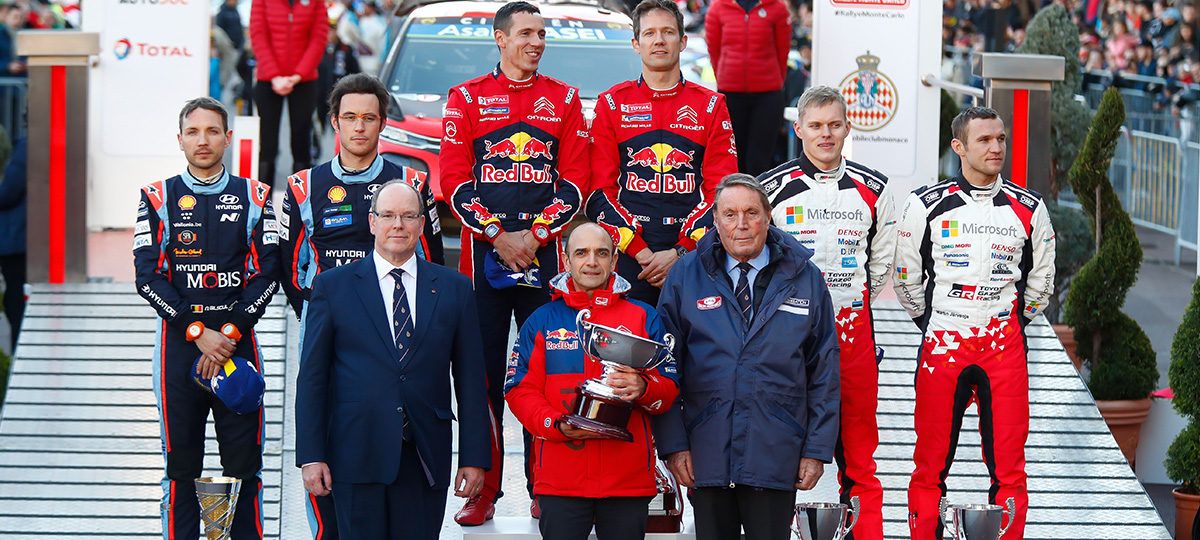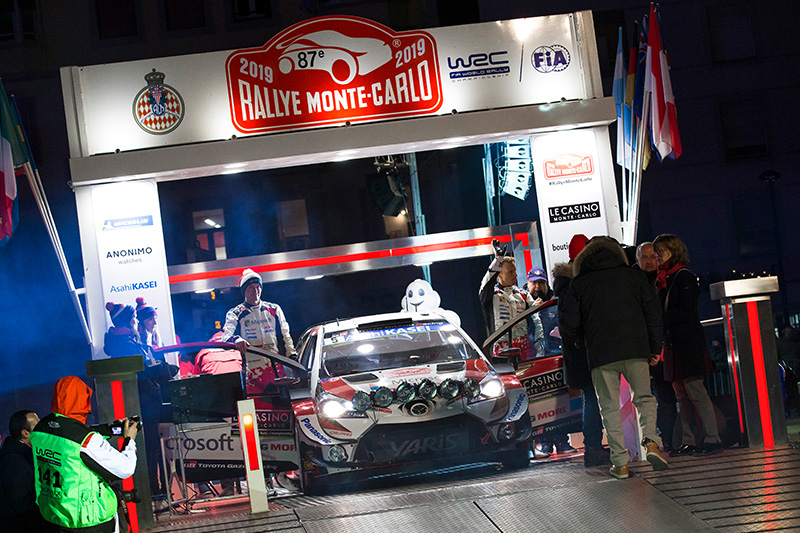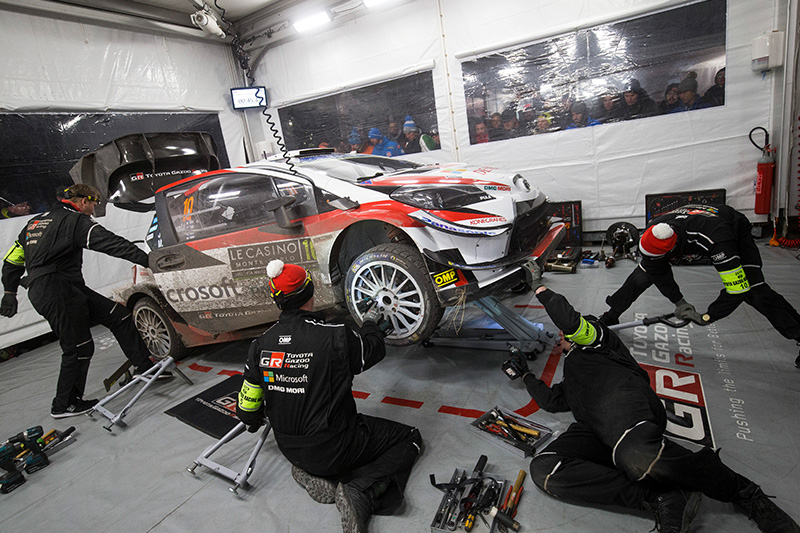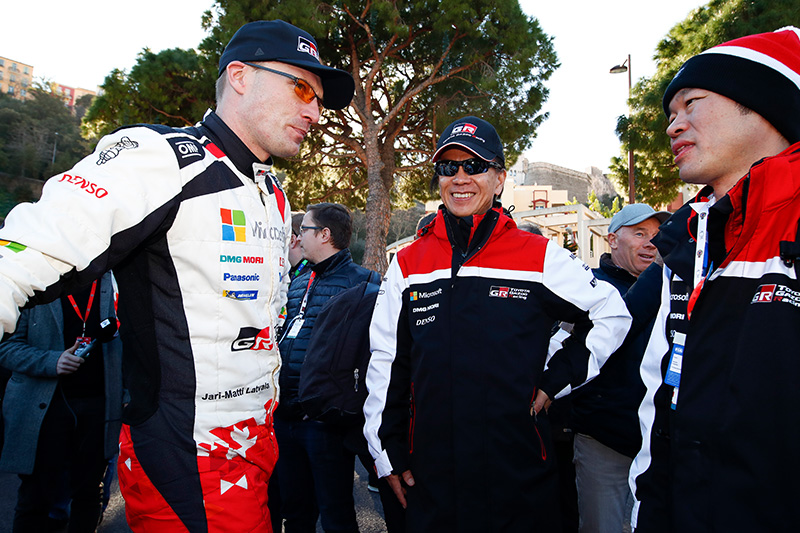2019 Rd.1 RALLYE MONTE-CARLO
WRC 2019 ROUND 1 RALLYE MONTE-CARLO

SUMMARY REPORT
The team secures a podium finish for the third year in a row at the season-opening Rallye Monte-Carlo
In 2018, the second year of its return to the World Rally Championship, the TOYOTA GAZOO Racing World Rally Team won the manufacturers’ championship; on the other hand, the team was unsuccessful in its bid to win the drivers’ and co-drivers’ titles. The 2019 season marked the third year of its return to WRC and, using the motto of “ALL FOR WIN,” the team had set itself the lofty goals of winning all three championships. However, in order to achieve these goals against powerful rivals, the entire team would have to be strengthened. For this reason, the team sought to further improve all aspects of the team, including its cars, its staff, and its drivers.

To begin with, the team added veteran driver Kris Meeke, accompanied by co-driver Seb Marshall to its lineup. Meeke boasts a long career in the sport, and has helped to drive powerful teams forwards; he also originally trained as an engineer, and this means he has a wealth of knowledge about car-making. Using his knowledge and experience, TOYOTA GAZOO Racing WRT hope to further improve the performance of its Yaris WRC. More than that, however, the team was attracted to Meeke by his speed. The Northern Irishman is capable of winning stages and competing for rally victories; and, if various elements fall into place, he also has the ability to fight for the drivers’ championship. It was this speed that convinced TOYOTA GAZOO Racing WRT to add Meeke to the team.
As far as its staff were concerned, TOYOTA GAZOO Racing WRT aimed to further energize its group of engineers. There was a review of the engineers in charge of each driver, and some engineers were given roles in both the test team and the event team. In addition, by employing new engineers from outside the company, TOYOTA GAZOO Racing WRT incorporated fresh approaches to development. As a result, the engineering team developed the capacity to engage in car-making in a more flexible manner than ever before.

The Yaris WRC won five rallies during the 2018 season, and the team focused on increasing its overall performance. Team Principal Tommi Mäkinen is of the belief that balance must be prioritized above all else in a rally car, and does not like the car to be dominated by a single, outstanding performance. For him, it is only when every element of the car—the body, suspension, drive system, and engine—is in harmony that the drivers can drive with confidence. All team members came to share Mäkinen’s belief, and the entire Yaris WRC was made superior to last season’s model. While there is little difference in the external appearance of the car, the basic performance of the 2019 Yaris WRC has been definitively improved. The car has also been made more durable and more responsive to enable it to challenge throughout the WRC series.

At the season-opening Rallye Monte-Carlo, Jari-Matti Latvala had claimed second place in 2017, while in 2018 Ott Tänak had taken second, with teammate Latvala in third. It was evidently a rally that suited the team. Though the event is primarily held on paved roads, the road conditions vary significantly from year to year and from stage to stage, with a mix of dry, wet, fresh snow, half-melted snow, and icy surfaces. In such difficult conditions, drivers must have confidence in their cars if they want to unlock their full performance. The first stage was held in the neighborhood of Gap, in the south of France, and Tänak recorded the fastest time to take the rally lead.

In second place on SS1 was Meeke, who was competing in the Yaris WRC for the first time. Having driven in dark and difficult conditions, Meeke was overwhelmed by a multitude of emotions after completing the stage: “I’ve been wanting to compete again for a long time. I’ve been waiting for this moment for many months, and the car gave me confidence. I was able to drive with confidence on my first stage in the car.” The team staff and fans who had been watching Meeke speak live on television broke into loud cheers and thunderous applause. Despite a blank of more than eight months, Meeke’s performance on the first stage demonstrated he was ready to compete at the top level of WRC immediately. There appeared to be a message in the continued applause of the fans: “Welcome back, Kris.”

Although Tänak had taken the rally lead after Day One’s night stage, he was soon to lose the lead on Day Two. Three Special Stages were scheduled for the morning of Day Two, but the first of these three stages, SS3, was suddenly cancelled. The TOYOTA GAZOO Racing World Rally Team were convinced that SS3, with its numerous sections of snow and ice, would hold the key to overall victory; for this reason, they chose a setup and tires that would optimize the Yaris WRC for this particular stage. However, the cancellation of SS3 meant that the car was unable to demonstrate its full performance, and its setup was not optimized for SS4 that followed. Tänak attacked, but his times were uncompetitive, his tires were gradually worn away, and he was significantly off the pace in SS5 as well. Tänak dropped to third overall, some 16.9 seconds off the lead.

In a bid to retrieve the time he lost in the morning, Tänak vowed to fight back in the afternoon stages. However, a puncture on SS7 saw him lose a further two minutes. Meeke also punctured on the same stage after damaging his rim and lost close to four minutes. Now, neither driver had realistic chances of victory. The 2019 Rallye Monte-Carlo had less snow than usual, and this meant that drivers could position their inner-front wheels in the unpaved, inside sections of corners, which would typically have been covered in snow. This technique enables drivers to minimize the distance they have to travel, but it also increases the likelihood of tire and wheel damage due to the difference in level between paved and unpaved sections. Nevertheless, since rim damage is almost unheard of at the Rally Monte-Carlo, the team was unable to hide its astonishment at its drivers’ misfortunes; this turned into a valuable lesson for the team, who learned that such scenarios were possible. The team took immediate measures to ensure such an accident would not reoccur at the next tarmac rally—the Tour de Corse, which takes place in March.

Despite having issues with his car setup, Latvala had managed a series of solid performances to end Day Two in fourth overall, and was in a strong position to challenge for a podium finish. While his times were not as eye-catching as those of his two teammates, he performed steadily in stage after stage and waited for his opportunity. Latvala had started to adopt this calm, seasoned style of competing in the second half of last season, and used it to accumulate a large number of manufacturers’ points. Consequently, the team’s belief in the dependability of Latvala as a driver has most certainly increased.

On Day Three, the Yaris WRC revealed its true potential: the crew achieved 1-2 finishes on all four stages. Tänak posted the fastest time on four consecutive stages, with Meeke second fastest on three; Latvala also recorded one second-best time as he continued a fierce battle with his rivals for third overall. Although Day Three showed the best of the Yaris WRC, the team was undertaking huge challenges behind the scenes. Lots of snow and ice remained on the afternoon courses, and Tänak was the only works team driver to opt for studless snow tires; the others all prioritized safety and chose spiked tires. The Estonian knew he could not expect to go significantly faster than his rivals if he chose the same approach, so, on the back of information from the safety crew—who drive the course just before the SS begins—and the opinions of his engineers, Tänak opted to run studless tires. The chance of a podium finish had not disappeared completely, but if he wanted to finish in the top three, he would have to go out of his comfort zone. Tänak chose the riskier option, which nevertheless had plenty of support, and succeeded in cutting the gap to the leaders.

There are multiple tires available for selection at the Rallye Monte-Carlo, and choosing the right tire is extremely difficult. Previously, the team would rely on the experience of the team staff and drivers for the majority of such decisions. This season, however, the team has strengthened its collaboration with TOYOTA Connected—a company that specializes in IT—and fully implemented the advanced IT tools developed by the company’s European branch for the first time. As a result, the team is now able to carry out a more scientific analysis of course conditions, and the tools played an important role during the Rallye Monte-Carlo as well. For Shigeki Tomoyama, president of both Connected Company and the GAZOO Racing Company, the aim was to create crossovers between IT and motorsports, and these linkups were fully implemented for the first time at the Rallye Monte-Carlo. The techniques and experience gained at the rally will be fed back into the development of production vehicles.

Heading into the final day of the rally, Latvala was the best-placed TOYOTA GAZOO Racing driver in fourth position; Tänak was 15 seconds behind in fifth. Latvala had continued to battle bravely with his rivals for third place, but Tänak also had the podium in his sights. In the end, it was Tänak who recorded fastest times on the day’s first two Special Stages and rose to third overall. He was able to maintain his position in the overall standings to the end of the rally, and thereby secured his third podium finish at Monte-Carlo in three years. While the result was not as good as last season’s second place, in the context of the championships as a whole, Tänak’s recovery from seventh overall was extremely significant. His seven stage wins were also the most of any driver. It therefore turned out to be a superb start to Tänak’s bid to win the drivers’ championship.

Following his puncture, Meeke was in no position to compete for the top places in the overall standings; instead, he bet everything on the rally-ending Power Stage and the bonus championship points that were on offer. The top two drivers were locked in a battle for overall victory until the final stage, and went on the offensive in the Power Stage. However, it was Meeke who recorded the fastest time, achieving his first stage win of the rally, and his first stage win since joining the TOYOTA GAZOO Racing World Rally Team. Although he could only manage sixth place in the overall standings, after finishing the rally with a stage win Meeke received the same, warm applause as he had after SS1. Meeke had taken a powerful first step as a member of the TOYOTA GAZOO Racing.

Latvala, who had been involved in a tight battle for third on the final day, finished fifth overall. He had stood on the Monte-Carlo podium in his first two years at the team and, unable to repeat the feat in 2019, Latvala was hugely disappointed. However, his performances were clearly steadier than both of his teammates over the weekend. Remaining strong no matter what situation he finds himself in, and steadily accumulating points, will be crucial for his season as a whole. The next event is Rally Sweden, where Latvala scored his first rally win for TOYOTA GAZOO Racing in 2017. An expert in snow rallies, Latvala will set his sights on the top step of the podium.

| Pos | Driver | Co-Driver | Vehicle | Time | |
|---|---|---|---|---|---|
| 1 | Sebastien Ogier | Julien Ingrassia | Citroën C3 WRC | 3h21m15.9s | |
| 2 | Thierry Neuville | Nicolas Gilsoul | Hyundai i20 Coupe WRC | +2.2s | |
| 3 | Ott Tänak | Martin Järveoja | Toyota Yaris WRC | +2m15.2s | |
| 4 | Sebastien Loeb | Daniel Elena | Hyundai i20 Coupe WRC | +2m28.2s | |
| 5 | Jari-Matti Latvala | Miikka Anttila | Toyota Yaris WRC | +2m29.9s | |
| 6 | Kris Meeke | Seb Marshall | Toyota Yaris WRC | +5m36.2s | |
| 7 | Gus Greensmith | Elliott Edmondson | Ford Fiesta R5 | +13m04.6s | |
| 8 | Yoann Bonato | Benjamin Boulloud | Citroën C3 R5 | +13m56.5s | |
| 9 | Stephane Sarrazin | Jacques-Julien Renucci | Hyundai i20 R5 | +14m06.8s | |
| 10 | Adrien Fourmaux | Renaud Jamoul | Citroën C3 R5 | +16m03.4s |
- RELATED TOPICS
-
-
TOYOTA GAZOO Racing World Rally Team
launches 2019 challenge at the Autosport International showThe 2019 FIA World Rally Championship season has been launched today in front of thousands of motorsport fans at the Autosport International show in Birmingham, England. TOYOTA GAZOO Racing World Rally Team is in attendance with its manufacturers’ championship-winning Yaris WRC car and its full squad of drivers and co-drivers. -
WRC 2019 ROUND 1 RALLYE MONTE-CARLO Gallery
-